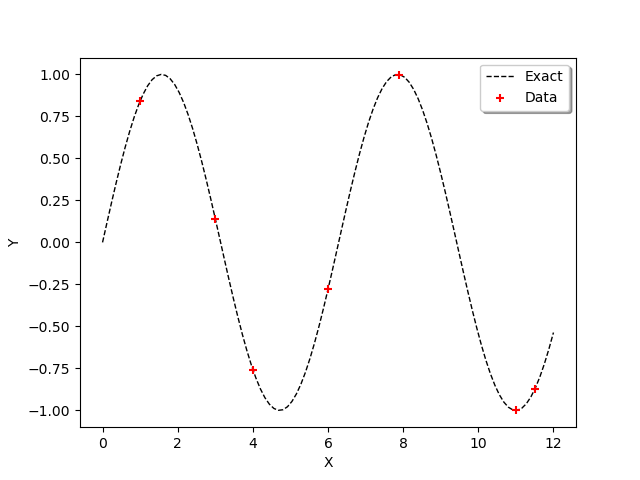Note
Go to the end to download the full example code.
Kriging : generate trajectories from a metamodel¶
The main goal of this example is to show how to simulate new trajectories from a Kriging metamodel.
Introduction¶
We consider the sine function:
for any .
We want to create a metamodel of this function. This is why we create a sample of observations of the function:
for , where
is the i-th input and
is the corresponding output.
We consider the seven following inputs :
1 |
2 |
3 |
4 |
5 |
6 |
7 |
|
1 |
3 |
4 |
6 |
7.9 |
11 |
11.5 |
We are going to consider a Kriging metamodel with a
constant trend,
a Matern covariance model.
Creation of the metamodel¶
We begin by defining the function g as a symbolic function. Then we define the x_train variable which contains the inputs of the design of experiments of the training step. Then we compute the y_train corresponding outputs. The variable n_train is the size of the training design of experiments.
import openturns as ot
import openturns.viewer as viewer
from matplotlib import pylab as plt
ot.Log.Show(ot.Log.NONE)
g = ot.SymbolicFunction(["x"], ["sin(x)"])
x_train = [[x] for x in [1.0, 3.0, 4.0, 6.0, 7.9, 11.0, 11.5]]
y_train = g(x_train)
n_train = len(x_train)
n_train
7
In order to compare the function and its metamodel, we use a test (i.e. validation) design of experiments
made of a regular grid of 100 points from 0 to 12.
Then we convert this grid into a Sample and we compute the outputs of the function on this sample.
xmin = 0.0
xmax = 12.0
n_test = 101
step = (xmax - xmin) / (n_test - 1)
myRegularGrid = ot.RegularGrid(xmin, step, n_test)
x_test = myRegularGrid.getVertices()
y_test = g(x_test)
In order to observe the function and the location of the points in the input design of experiments, we define the following functions which plots the data.
def plot_data_train(x_train, y_train):
"""Plot the data (x_train,y_train) as a Cloud, in red"""
graph_train = ot.Cloud(x_train, y_train)
graph_train.setColor("red")
graph_train.setLegend("Data")
return graph_train
def plot_data_test(x_test, y_test):
"""Plot the data (x_test,y_test) as a Curve, in dashed black"""
graphF = ot.Curve(x_test, y_test)
graphF.setLegend("Exact")
graphF.setColor("black")
graphF.setLineStyle("dashed")
return graphF
graph = ot.Graph()
graph.add(plot_data_test(x_test, y_test))
graph.add(plot_data_train(x_train, y_train))
graph.setAxes(True)
graph.setXTitle("X")
graph.setYTitle("Y")
graph.setLegendPosition("upper right")
view = viewer.View(graph)

We use the ConstantBasisFactory class to define the trend and the MaternModel class to define the covariance model.
This Matérn model is based on the regularity parameter .
dimension = 1
basis = ot.ConstantBasisFactory(dimension).build()
covarianceModel = ot.MaternModel([1.0] * dimension, 1.5)
algo = ot.KrigingAlgorithm(x_train, y_train, covarianceModel, basis)
algo.run()
krigingResult = algo.getResult()
krigingResult
We observe that the scale and amplitude hyper-parameters have been optimized by the run method. Then we get the metamodel with getMetaModel and evaluate the outputs of the metamodel on the test design of experiments.
krigeageMM = krigingResult.getMetaModel()
y_test_MM = krigeageMM(x_test)
The following function plots the Kriging data.
def plot_data_kriging(x_test, y_test_MM):
"""Plots (x_test,y_test_MM) from the metamodel as a Curve, in blue"""
graphK = ot.Curve(x_test, y_test_MM)
graphK.setColor("blue")
graphK.setLegend("Kriging")
return graphK
graph = ot.Graph()
graph.add(plot_data_test(x_test, y_test))
graph.add(plot_data_train(x_train, y_train))
graph.add(plot_data_kriging(x_test, y_test_MM))
graph.setAxes(True)
graph.setXTitle("X")
graph.setYTitle("Y")
graph.setLegendPosition("upper right")
view = viewer.View(graph)

Simulate new trajectories¶
In order to generate new trajectories of the conditioned Gaussian process,
we could technically use the KrigingRandomVector class, because it provides
the getSample method that we need.
However, the KrigingRandomVector class was more specifically designed to
create a RandomVector so that it can feed, for example, a function which has a field as input argument.
This is why we use the ConditionedGaussianProcess, which provides a Process.
process = ot.ConditionedGaussianProcess(krigingResult, myRegularGrid)
trajectories = process.getSample(10)
type(trajectories)
The getSample method returns a ProcessSample.
By comparison, the getSample method of a KrigingRandomVector would return a Sample.
graph = trajectories.drawMarginal()
graph.add(plot_data_test(x_test, y_test))
graph.add(plot_data_train(x_train, y_train))
graph.setAxes(True)
graph.setXTitle("X")
graph.setYTitle("Y")
graph.setLegendPosition("upper right")
graph.setTitle("10 simulated trajectories")
view = viewer.View(graph)
plt.show()
# sphinx_gallery_thumbnail_number = 3

References¶
Metamodeling with Gaussian processes, Bertrand Iooss, EDF R&D, 2014, www.gdr-mascotnum.fr/media/sssamo14_iooss.pdf
 OpenTURNS
OpenTURNS